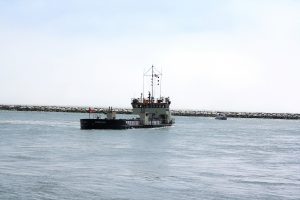
OCEAN CITY — While it remains to be seen how the local share of a proposed $1.2 million study of a long-term solution to the Inlet shoaling problem will be patched together, continued short-term maintenance dredging got a fiscal shot in the arm this week.
The federal Army Corps of Engineers (ACE) this week announced an additional $500,000 for continued maintenance dredging at the Ocean City Inlet has been added to the Corps’ already approved $250,000. The funding, which essentially triples the money earmarked for occasional dredging of the Inlet navigation channel in Ocean City, was allocated through the Army Civil Works Program.
The ACE fiscal year 2018 budget already included $250,000 for the continued dredging of the Inlet. The special allocation approved by Congress and announced by ACE officials on Monday represents a different allocation and helps ensure the occasional maintenance dredging carried out by the corps’ shallow draft dredge vessels Murden and Currituck will continue throughout the next year.
“Long story short, as far as the Ocean City Inlet is concerned, the recently announced fiscal year 2018 work plan clarifies that the Army Corps Baltimore District will be receiving $750,000 in navigation-specific funding for the Ocean City Inlet, which is $500,000 more than was originally proposed for the Inlet in the fiscal year 2018 budget,” said Chris Gardner of the ACE Baltimore District Corporate Communication Office. “This money will be used to dredge the Inlet over the course of the next year or so, based on the conditions of the channel and the availability of shallow-draft dredges such as the Currituck and Murden.”
The Inlet and other channels in and around the commercial harbor naturally fill in and are in constant need of maintenance dredging, but the problem has become more acute in recent years to the point the Inlet is often impassable and unnavigable for larger vessels on even the highest of tides. While maintenance dredging will continue thanks in large part to the supplementary funding announced this week, local, state and federal officials have been exploring a long-term solution including dredging the Inlet channel to a greater depth and possibly even a reconfiguration of the jetties or a relocation of the channel.
The Inlet is ACE’s responsibility and the federal agency has shown a willingness to be part of the solution. However, before any major changes take place in the Inlet, ACE wants to conduct a feasibility study to chart a course for action. The study is a necessary first step and is essentially a requirement before the federal government invests potentially millions of dollars into a long-term fix.
ACE’s study is expected to cost $1.2 million, of which the federal government would fund half, or $600,000. The remaining $600,000 would be funded by a combination of state and local sources including 50 percent, or $300,000 from the state and 25 percent each, or $150,000 each from Worcester County and the Town of Ocean City. However, the Town of Ocean City and Worcester County remain at odds on how to split the local share, if at all.
ACE’s next scheduled dredging project in the Inlet is set for later this fall, and that project was already planned and would have happened regardless of Monday’s supplementary funding. According to Gardner, Monday’s announcement ensures a steady stream of federal funding into next year and beyond.
“This is a previously scheduled dredging and not related to the above funding,” he said. “The above funding will be used to schedule future dredge visits as needed from this fall into 2019 based on the conditions of the channel and the availability of shallow-draft dredging.”
One of the ACE shallow-draft dredge vessels, either the Murden or the Currituck, is scheduled to arrive in Ocean City by the end of July and work through much of August. The project will largely consist of Assateague bypass work, which involves dredging the Inlet as well as the ebb and flow shoals nearby and depositing that material off the coast of Assateague as part of the barrier island’s ecosystem restoration. However, the project later this summer will also set aside an additional three days dedicated to just dredging the Inlet channel. The August dredging project will be funded by previously available navigation funding, with the new funding announced this week set aside for future projects.
The Inlet is currently authorized to be dredged to a depth of 10 feet, but the conventional thinking is increasing the depth to 14 or even 16 feet would cure the shoaling problem. There could also be some reconfiguration of the existing jetty system to alleviate some of the shoaling issues. Regardless, the long-term fix will likely require a significant investment in federal dollars, probably in the tens of millions.

